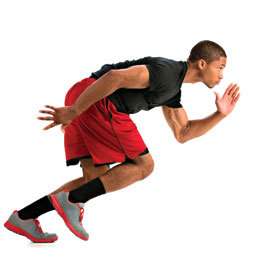
Keeping your student athlete safe during the approaching sports season.
As a new school year kicks off, many of the fall sports practices are already underway. Across the United States, nearly 30 million children and adolescents participate in youth sports—more than ever before. While it’s great that kids are becoming more active, along with the increased play comes a rising rate of sports-related injuries. In fact, high school athletes account for an estimated two million injuries and 30,000 hospitalizations each year.
As athletes gear up for their season, it’s important that they take injury prevention to heart.
Dr. Fred McAlpin, III, orthopaedic surgeon and sports medicine specialist with Premier Orthopaedic Associates, says these days, many athletes are going back to their sport earlier in the season. Fall sports are already underway well before school even begins.
“That’s okay, as long as it’s a gradual process and not a shock to the system,” McAlpin says. “In many ways, that extra time can be beneficial. For instance, if a runner gets right back into long-distance runs, that athlete will have a greater chance of injury than a runner who is easing back in with some shorter runs, and building strength and endurance at a steady pace.”
Deconditioning can definitely occur over the summer, adds Burlington County Orthopaedic Specialists’ Dr. Mark G. Schwartz, co-director of Virtua Health’s Sports Medicine Program and chief of orthopaedics and chairman of the department of surgery at Virtua Memorial Hospital of Burlington County.
“If athletes have taken off the summer, they might not be ready for the season to kick off,” Schwartz says. “It’s common to lose flexibility with time off. Some kids may also be going through a growth spurt, which further decreases flexibility. If deconditioned, it’s important to ease back in.”
Since so many fall athletes start their season in the summer, they do need to take the heat into account. Scott DeLange, a certified athletic trainer with five years of experience in the high school setting from The Field House in Moorestown, says that heat-related incidents are common in the early season. These include heat exhaustion and cramps.
“These occur when athletes are poorly hydrated and not used to working out in the heat for long periods of time,” DeLange warns. “Make sure that you are properly fueling and hydrating your body for performance. Showing up to a workout on an empty stomach or dehydrated will drastically affect your athletic performance. It has been proven that being dehydrated as little as 1 to 2 percent can decrease your athletic performance by as much as 10 percent.”
The whole body
As athletes begin training, they’re likely headed back to the weight room. In strength training, it’s important that athletes are paying attention to doing a whole body workout. Dr. Peter F. DeLuca, an accomplished orthopaedic surgeon and sports medicine specialist with the Rothman Institute, as well as the head team physician for the Philadelphia Eagles, and head orthopaedic surgeon for the Philadelphia Flyers, says that athletes need to avoid just working those “mirror muscles” that they want to show off on the field.
“A lot of athletes like having big biceps but they really need to put more focus on a full body workout program,” DeLuca says. “The core muscles are so important. There is a misconception that the core is just the abdominal muscles when in fact it also includes the pelvic, gluteal, back, hip flexors and quad muscles. In order to adequately strengthen everything else, you must have a stable core.”
DeLuca says more high school athletes have become involved in programs such as Pilates, which is an excellent program to strengthen the core. He says a stable core will not only lead to greater athletic ability, but will also lessen the chance of injury.
Stretching is also an important part of preventing injury. DeLuca says many athletes skimp in this area. They may do a few simple stretches before jumping right into their workout. But stretching isn’t the warm-up. It’s important that the muscles are warmed up before stretching.
“Do a little jogging in place or some jumping jacks—any low-intensity exercise that produces a bit of sweat,” says DeLuca. “The analogy I use is stretching taffy. If taffy is cold, it’s very hard to stretch, but as soon as it’s warmed up, it becomes easy. The same thing pertains to the tendons and muscles. Once your muscles and tendons are warmed up, you can stretch more easily and effectively.”
McAlpin says it’s all about easing into the workout.
“It’s so important to gradually get into your activity,” he says. “You shouldn’t just start at a hard sprint—that’s when injuries happen. Do some jumping jacks or a few easy strides. Bring the blood flow back to those muscles so they aren’t tight and can respond better when you do ask them for high-demand such as sprinting.” And don’t forget the cool down.
“Athletes tend to skip the cool down,” says Schwartz. “But it’s an important part of the overall workout. Take your victory lap. Those extra five minutes of stretching and cooling down can help prevent injury. It’s like driving a fine sports car. You have to let the engine cool down to keep it operating at its best.”
Making good choices
There are certainly some sports injuries that just can’t be prevented. But many can. A lot of it does come down to making wise choices. Jamie McCulloh-Martin, PT, with Strive Physical Therapy & Sports Rehabilitation; says that high school athletes should remember that colleges like to recruit injury-free players.
“And the injury-free athlete doesn’t just happen by chance,” she adds.
Some intentional decisions can help reduce the risk of injury. These include staying hydrated, eating well, and incorporating a dynamic warm-up and cool down, says McCulloh-Martin. Athletes should also stay focused during practice and games.
Of course you also need to pay attention to your body. While many athletes are still in the old-school mindset of “no pain, no gain,” says DeLuca, pain is a sign that something is wrong.
“Pain is your body telling you something isn’t right,” he adds. “If you ignore it, you will injure that structure. If you’re having pain during a workout, take some rest. Most orthopaedic problems do get better with rest.”
McAlpin agrees.
“Too often athletes ignore pain and wind up injuring themselves because of it,” he warns. “Any pain that affects play is a red flag that the athlete might need some rest. And if that pain nags longer than two weeks, it’s time to get it looked at. Those who are unwilling to take some downtime are putting themselves at higher risk for a more serious injury.”
Resources
Burlington County Orthopaedic Specialists
204 Ark Road | Mount Laurel
(856) 235-7080 | BCOS.us
The Field House in Moorestown
605 Glen Ave. | Moorestown
(856) 581-9293
FieldHouseMoorestown.com
Premier Orthopaedic Associates
Locations in Mullica Hill, Woolwich, Vineland, and Elmer
POASNJ.com
Rothman Institute
Serving South Jersey
RothmanInstitute.com
Strive Physical Therapy & Sports Rehabilitation
500 Lippincott Drive | Marlton
(856) 334-4100
StrivePhysicalTherapy.com
Virtua Memorial Hospital of Burlington County
175 Madison Ave. | Mount Holly
(609) 914-6000 | Virtua.org
Published (and copyrighted) in the Art of Living Well pull-out section of Suburban Family Magazine, Volume 6, Issue 6 (August, 2015).
For more info on Suburban Family Magazine, click here.
For information about advertising in Suburban Family Magazine, click here.
To find out where to pick up your copy of Suburban Family Magazine, click here.




